Inside this Article
Features
Mailchimp’s Feature Set Is More Robust
GoDaddy’s email templates are limited to just 27, while Mailchimp boasts around 100. Mailchimp’s pre-made templates look better and have a more professional look. They’re also more customizable, thanks to Mailchimp’s sophisticated email editor. With Mailchimp, you can drag-and-drop any element you want to create fully-customized emails – GoDaddy is somewhat restrictive with its options.
Ease of Use
Mailchimp Is More Intuitive; GoDaddy Has Better Tutorials
Even though it has many features, I found Mailchimp very easy to use. The intuitive drag-and-drop editor allows you to position elements exactly where you want them with minimal effort. A/B testing is easily accessible through the main menu, segmentation is simple, and there are many pre-built automation workflows available. Mailchimp also displays helpful tips from time to time, providing actionable advice when certain conditions are met. GoDaddy, on the other hand, is easy to use because it lacks so many features. You can’t add your own block elements to your emails, which means you’re limited to editing what’s already there. Its segmentation options are decent, and managing lists is easy, but that’s pretty much it. There’s no option to craft an email from scratch, no automation, no A/B testing, and the list goes on. Both platforms are easy to use, but this round goes to Mailchimp for remaining user-friendly despite its extensive feature set.Deliverability
Your Emails Will be Delivered as Long as You Stick to the Rules
Marketers spend countless hours optimizing their campaigns down to the last CTA. Still, their efforts mean nothing if the emails aren’t reliably delivered to their subscribers. High deliverability rates are crucial, but traditional deliverability tests don’t always tell the whole story. Let’s say I run some tests and come up with an arbitrary number (e.g., 93%). Does that offer any real value when there are so many variables that affect the sending process? Most of the time, these tests say more about the marketer than the EMS itself. A better way to gauge a platform’s deliverability is by examining specific features we know from experience to boost performance. My colleague explains why and how we do this in our in-depth deliverability guide. First, I needed to make sure there was DKIM authentication. Long story short, that’s how email providers know it’s really you sending the emails in your name. As you’d expect, both GoDaddy and Mailchimp have DKIM, and you can set it up quickly with easy-to-follow guides.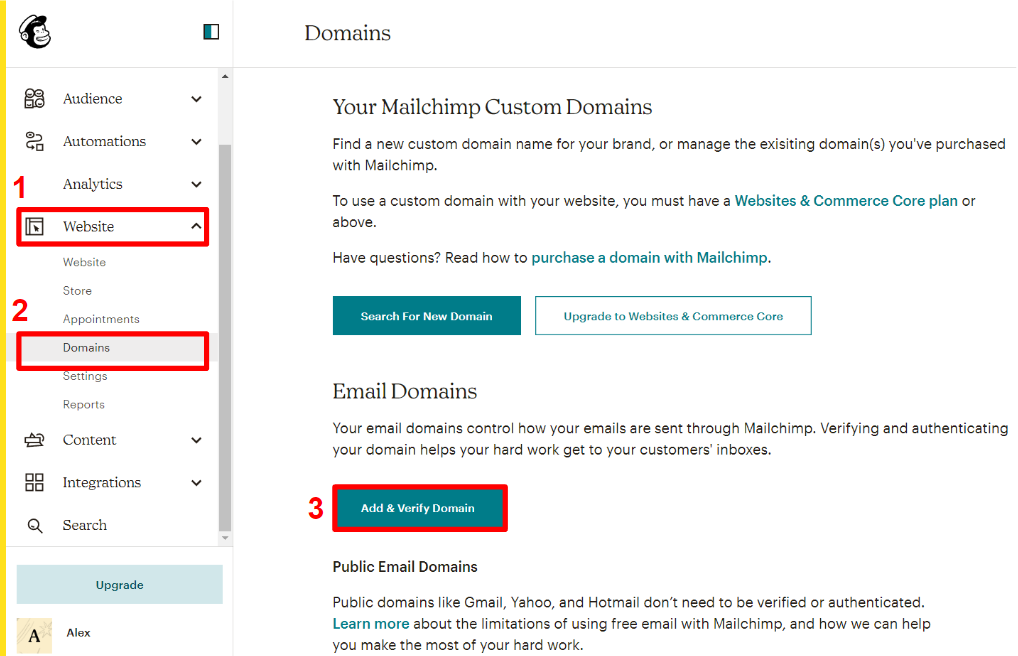
Reporting and Analytics
GoDaddy Analytics Is Slightly Better Than Mailchimp’s Reporting
Email marketing reports aren’t very useful unless they allow comparisons or include marketing insights. GoDaddy’s standard reports do both, and technically Mailchimp does too – as long as you don’t mind paying a bit extra. Mailchimp’s standard reports include all the essential stats like open and click-through rates, e-commerce data, and audience analytics. With Mailchimp, you can also access campaign benchmarking with every plan. Don’t expect especially deep insights, as it’s only a surface-level report. If you want more, get ready to upgrade to Mailchimp’s most expensive plan to access comparative reporting.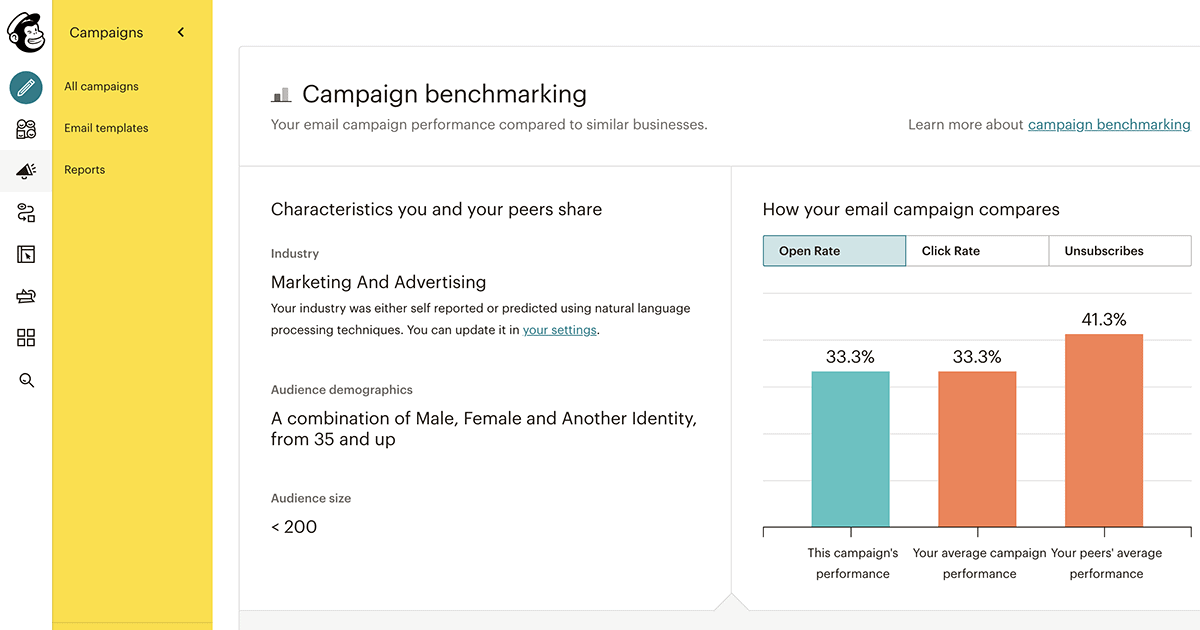
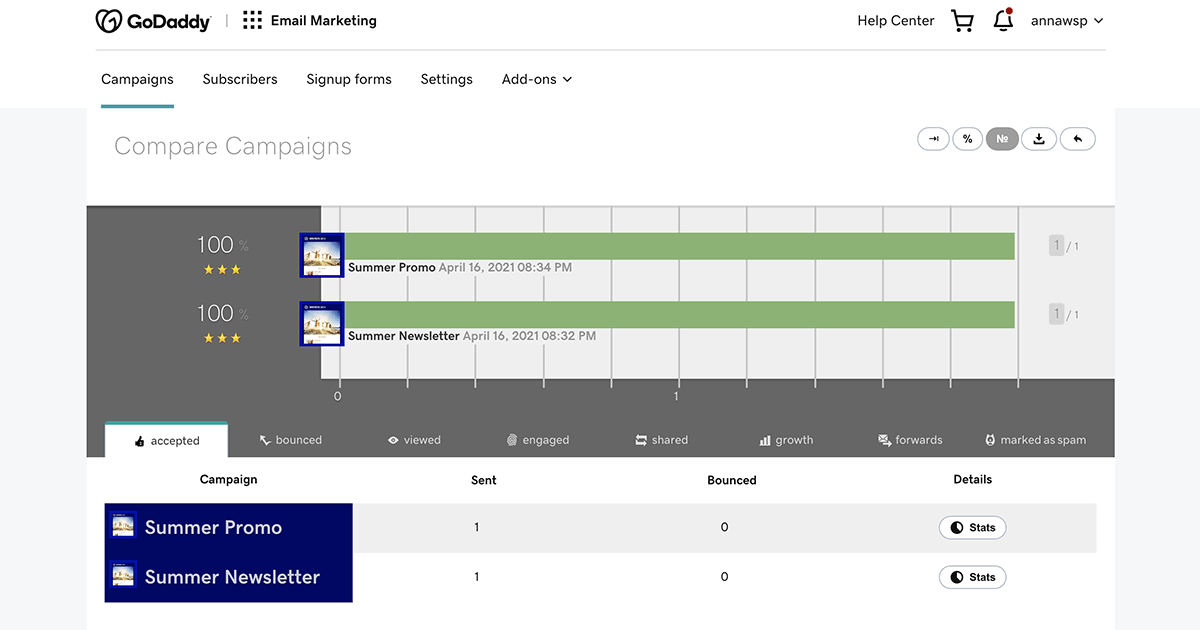
Pricing
Mailchimp Gets Pricey Fast; GoDaddy Is More Affordable – With a Catch
Mailchimp and GoDaddy Email Marketing have similar starting costs. However, the sending capacities and pricing methods are completely different, and Mailchimp’s highest-tier plan is exponentially more expensive.
Here’s What You Get For Free
GoDaddy Email Marketing doesn’t have a free plan beyond the Starter plan, which is more of a free trial with up to 50 email sends. In contrast, Mailchimp’s Free plan lets you send up to 1,000 monthly emails to as many as 500 subscribers. It includes customizable automations and landing pages but lacks key features like advanced reports and A/B testing.Here’s What You Get If You Pay
Before you sign up for a paid plan, calculate your costs carefully. Each GoDaddy Email Marketing plan has fixed costs, and you only pay more if you choose to upgrade. Mailchimp has contact-based pricing, so every time you reach a new subscriber limit, you have to pay more – even if you don’t need to upgrade to the next plan level. Even though GoDaddy Email Marketing seems inexpensive, it might cost more than you think. The cheapest plan is so restrictive it’s for beginners only, so the mid-tier plan is where most marketers should start. Beware that once you reach 5,000 subscribers, it’s impossible to add more or upgrade your GoDaddy Email Marketing plan further. If you anticipate building a big list, you’re better off choosing another service to begin with. Because Mailchimp has subscriber-based pricing, you can expect your costs to escalate quickly as you build your list. If you want advanced features like comparative reporting and multivariate testing, you’ll have to pay for the most expensive plan. Take a look at the chart below to compare the two services more easily. When you throw Brevo (formerly Sendinblue) into the mix, it’s clear that you can get similar or better features at a much lower cost.| Plan | # Subscribers | # Email Sends | Automations | Support | Monthly Price |
| GoDaddy Email Marketing: Beginner | 500 | 2,500 emails per month | limited autoresponders | 24/7 live chat and phone support | $9.99 per month |
| Mailchimp: Essentials | 500 | 5,000 emails per month | multi-step automations | 24/7 email & live chat support | $13.00 to start |
| Brevo (formerly Sendinblue): Free | Unlimited | 300 emails per day (approx. 9,000 emails per month) | customizable multi-step workflows | 24/7 email support | $0 |
Support
Mailchimp Can Be Slow; GoDaddy May Not Give an Accurate Response
GoDaddy and Mailchimp both have reasonable support options, at least theoretically. GoDaddy has 24/7 phone and live chat support for all plans. Mailchimp has 24/7 email and live chat support for most paid plans and phone support for the highest-tier plan. Yet I had issues with both platforms’ support methods. First, I used GoDaddy’s live chat to ask about personalizing emails with content or subscribers’ names. The support rep had a lot of trouble understanding what I was asking and then ultimately told me it was impossible to do what I wanted. After a few hours of testing the platform, I found that it absolutely is possible to personalize GoDaddy emails with subscriber names and other details – you just have to know where to look.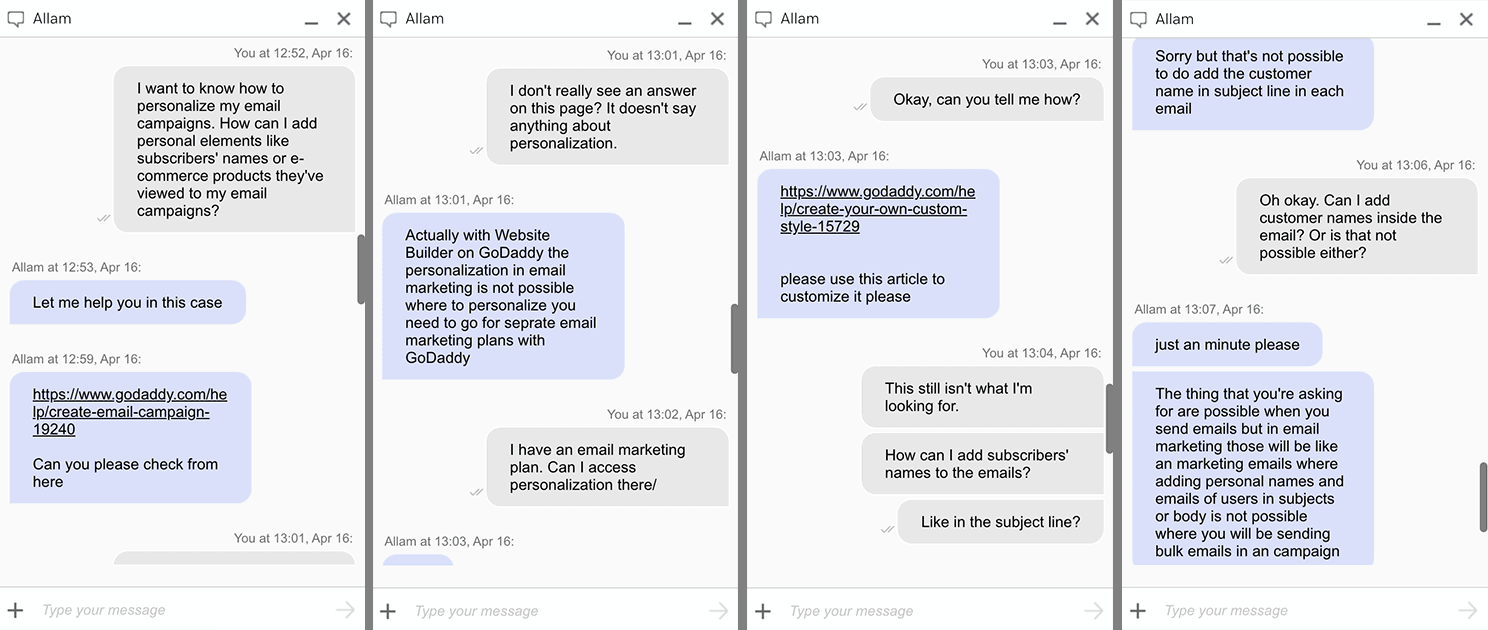
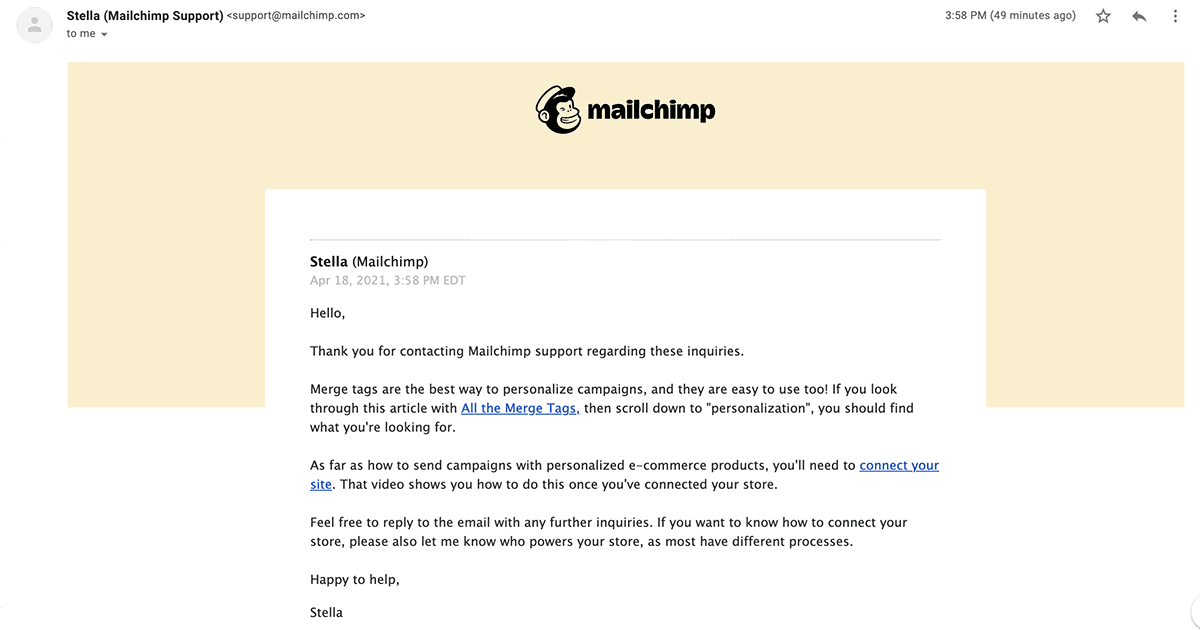
Mailchimp Does Quite a Bit More Than GoDaddy
If you want to focus on email marketing, a dedicated platform like Mailchimp would be a wise option. GoDaddy Email Marketing has better analytics and lower prices, but it can’t really compete with Mailchimp’s advanced features and reliable support. In comparison, GoDaddy’s email marketing suite feels almost like an afterthought or good-to-have extra – which is a bit of a shame. But what if you’re already using GoDaddy and just want to send a few emails once in a while? Doesn’t it make sense to go for a GoDaddy email plan? Well, not really. If you’re already on GoDaddy and have a small list or a strict budget, Mailchimp is probably still the better choice. You can test the platform and send 1,000 emails for free every month, upgrading when you’re ready for advanced features like A/B testing, pre-built automation workflows, and comparative reporting. Here’s a quick recap of everything we’ve looked at so far:GoDaddy
Mailchimp
Templates
27
100+ ✔
Automation
Poor
Great ✔
Native Integrations
5+
310+ ✔
A/B Testing
No
Yes ✔
Ease of Use
Easy to use
Easy despite robust feature set ✔
Deliverability
Good
Great ✔
Reporting and Analytics
Great ✔
Good
Pricing
Affordable ✔
Can get expensive
Support
Could be better
Great ✔
Total Rounds Won
2
7







![10 Best Email Marketing Software for Ecommerce [2025 Update]](https://dt2sdf0db8zob.cloudfront.net/wp-content/uploads/2023/08/Best-Email-Marketing-Software-for-Ecommerce-850x446.jpg)
![Keap vs Mailchimp: Which Offers Better Value? [2025 Update]](https://dt2sdf0db8zob.cloudfront.net/wp-content/uploads/2023/06/Keap-vs-Mailchimp-850x446.jpg)
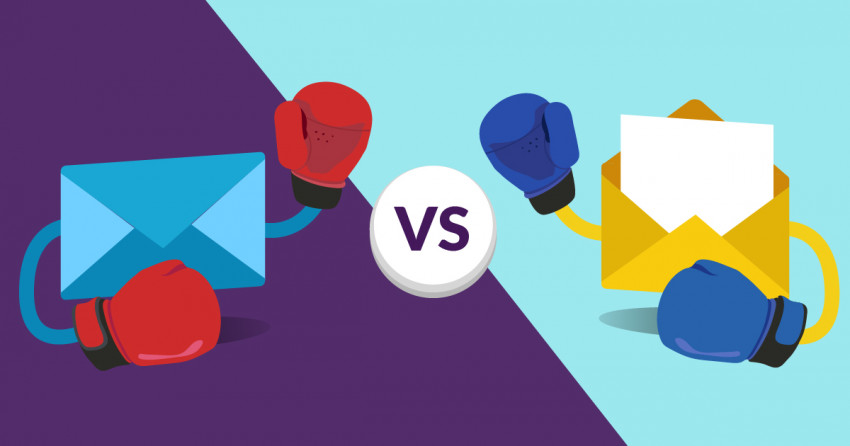
![Drip vs Mailchimp: Read Our Advice Before You Sign Up [2025]](https://dt2sdf0db8zob.cloudfront.net/wp-content/uploads/2022/10/Vs-1-850x446.jpg)
![Drip vs Mailchimp: Read Our Advice Before You Sign Up [2025]](https://dt2sdf0db8zob.cloudfront.net/wp-content/uploads/2022/08/Emily-Robin.jpg)
![MailerLite vs ConvertKit: Read This Before You Sign Up [2025]](https://dt2sdf0db8zob.cloudfront.net/wp-content/uploads/2022/10/Vs-850x446.jpg)


